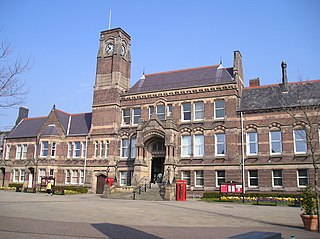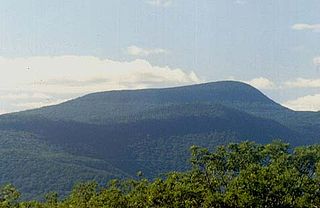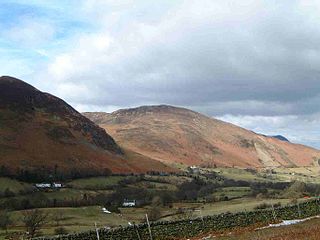Related Research Articles

Sgùrr Dearg is a mountain in the Cuillin on the Isle of Skye, Scotland. It is topped by the Inaccessible Pinnacle, a fin of rock measuring 50 metres (150 feet) along its longest edge. The top of the Inaccessible Pinnacle, which at 985.8 m (3,234 ft) is the highest point of Sgùrr Dearg and the only Munro with a peak that can only be reached by rock climbing. This makes it the biggest hurdle for many Munro baggers.

The Metropolitan Borough of St Helens is a metropolitan borough of Merseyside, in North West England. It is named after its largest town St Helens, and covers an area which includes the settlements of Earlestown, Rainhill, Eccleston, Clock Face, Haydock, Billinge, Rainford and Newton-le-Willows.

Mount Vernon is a residential area in the east end of the city of Glasgow, Scotland. It directly borders Sandyhills and Foxley to the west, while Barlanark is the closest neighbourhood to the north, Barrachnie and Baillieston to the east and Carmyle to the south, although Mount Vernon is separated from these by areas of open land, including Early Braes public park and the former Kenmuir farm.

Towradgi is a small beach-side suburb approximately 5 km (3.1 mi) north of Wollongong, New South Wales, Australia. Towradgi is derived from the Dharawal word Kow-radgi, meaning "guardian of the sacred stones". On an early map it was called Towroger. Towradgi is served by electric trains at Towradgi railway station, opened in 1948.

Snow removal or snow clearing is the job of removing snow after a snowfall to make travel easier and safer. This is done by both individual households and by governments and institutions.

Agricultural wastewater treatment is a farm management agenda for controlling pollution from surface runoff that may be contaminated by chemicals in fertiliser, pesticides, animal slurry, crop residues or irrigation water.

A spoil tip is a pile built of accumulated spoil – waste material removed during mining. These waste materials are typically composed of shale, as well as smaller quantities of carboniferous sandstone and various other residues. Spoil tips are not formed of slag, but in some areas, such as England and Wales, they are referred to as slag heaps. In Scotland the word bing is used.

Slide Mountain is the highest peak in the Catskill Mountains of the U.S. state of New York. It is located in the town of Shandaken in Ulster County. While the 4,180-foot (1,270 m) contour line on topographic maps is generally accepted as its height, the exact elevation of the summit has never been officially determined by the U.S. Coast and Geodetic Survey, and many informal surveys suggest the mountain may actually top 4,200 feet above sea level.
A treebog is a type of low-tech compost toilet. It consists of a raised platform above a compost pile surrounded by densely planted willow trees or other nutrient-hungry vegetation. It can be considered an example of permaculture design, as it functions as a system for converting urine and feces to biomass, without the need to handle excreta.

The Freetown-Fall River State Forest is a publicly owned forest covering more than 5,000 acres (2,000 ha) in the city of Fall River and the towns of Freetown and Lakeville in the state of Massachusetts. The forest lies mostly in the center of the town of Freetown dividing Assonet, East Freetown, and Fall River's northernmost boundary. The forest land includes Profile Rock, a granite outcropping which local Native Americans believe to be the image of Chief Massasoit, and a 227-acre (92 ha) Wampanoag reservation. The forest is owned by the Commonwealth of Massachusetts and operated by the Department of Conservation and Recreation with headquarters in Assonet.

The U.S. National Whitewater Center (USNWC) is an outdoor recreation and athletic training facility for ice skating, whitewater rafting, kayaking, canoeing, rock climbing, mountain biking, and hiking which opened to the public on November 4, 2006. The Center is located in Charlotte, North Carolina on approximately 1,300 acres (530 ha) of land adjacent to the Catawba River, with more than 45 miles (72 km) of developed trail.

Barrow is small fell in the English Lake District in the county of Cumbria which reaches a height of 455 metres (1,494 feet). It is in the Newlands Valley 2.5 miles (4 km) south-west of Keswick. Although comparatively small in height, Barrow commands an all-round view, with the vales of Keswick and Newlands being visible. The name of the fell originates from the Anglo Saxon language meaning a hill or long ridge.

Cuesmes is a village south-west of the Belgian city of Mons, and has been in the administration of the city of Mons since 1971, in the province of Hainaut. The famous artist, Vincent van Gogh, lived here during the years of 1879- 1880, at Maison Van Gogh. Because Van Gogh used to live in Cuesmes, many people who live there now are fans of Van Gogh and his art.

Swinley Forest is a large expanse of Crown Estate woodland mainly within the civil parishes of Windlesham in Surrey and Winkfield and Crowthorne in Berkshire, England.

Abbaretz is a commune in the Loire-Atlantique department in the Pays de la Loire region of western France.

Crothers Woods is an area of the Don River valley in Toronto, Ontario, Canada. It is 52 hectares in size and consists of woodland, meadows, wetlands, and an assortment of past and present municipal uses. The wooded area has been designated as an Environmentally Significant Area (ESA) by the Toronto and Region Conservation Authority. An ESA designation is useful in highlighting valuable natural areas but this does not affect planning uses. The area is currently zoned as undeveloped parkland. Crothers Woods was named after George W. Crothers who owned and operated an equipment dealership called Crothers Caterpillar which sold and serviced new and used heavy machinery for the construction and mining industries. The company stayed until 1979 when they relocated to Vaughan, Ontario. Murhal Developments bought the property and eventually sold it to Loblaws which built the store that currently occupies the site just off Millwood Road.

Tilgate Park is a large recreational park situated south of Tilgate, South-East Crawley. It is the largest and most popular park in the area.
Ancient iron production refers to iron working in times from prehistory to the early Middle Ages where knowledge of production processes is derived from archaeological investigation. Slag, the byproduct of iron-working processes such as smelting or smithing, is left at the iron-working site rather than being moved away with the product. It also weathers well and hence it is readily available for study. The size, shape, chemical composition and microstructure of slag are determined by features of the iron-working processes used at the time of its formation.

Buštěhrad slag heap is a huge artificial hill between municipalities of Kladno-Vrapice, Buštěhrad and Stehelčeves near Kladno in the Central Bohemian Region of the Czech Republic that have arisen in the late 20th century as a dumping site for slag from the Kladno ironworks, and other industrial waste. This is one of the most massive heaps of Kladno area, which, particularly when viewed from the northeast, forms by far visible and noticeable part of the landscape in shape of a mesa.
Turves Green is an area of Birmingham partly in West Heath and partly in Northfield. In addition the area of Longbridge borders Turves Green. A road with the simple name Turves Green runs through the area.
References
- ↑ healeyhero.co.uk Archived 2007-10-08 at the Wayback Machine
- ↑ thisischeshire.co.uk Archived 2007-09-27 at the Wayback Machine
- ↑ thisislancashire.co.uk [ permanent dead link ]
- ↑ messengernewspapers.co.uk